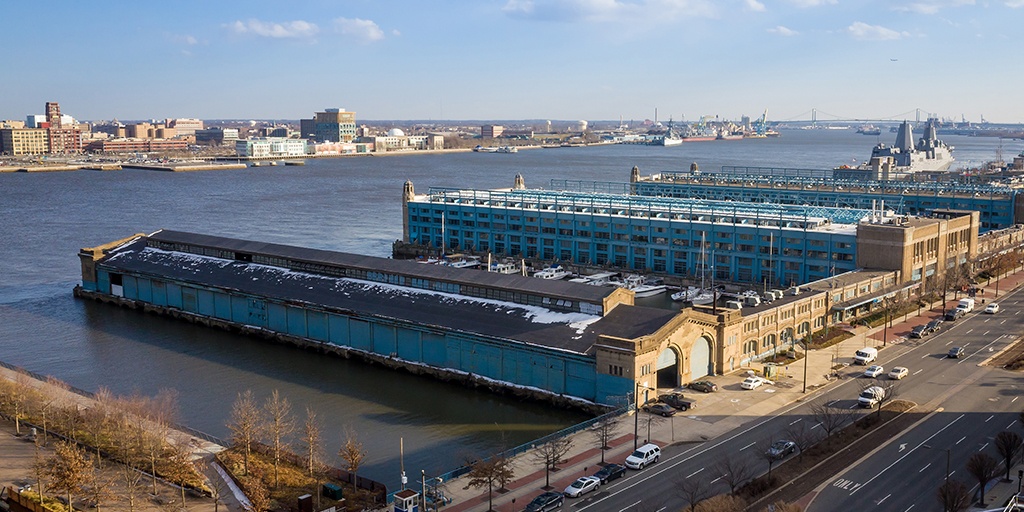Like all projects, adaptive reuse projects start with an idea. Over time, the idea grows into a plan and the plan grows into a movement that changes our city landscapes. This was the case with the Navy Yard in Philadelphia, which is now the nation’s most successful commercial adaptive reuse redevelopment of a former military facility.
The current space at the Navy Yard boasts 152 companies filling 7.5 million square feet and employing 12,000 people. It is fast becoming an important part of the urban fabric of the City of Brotherly Love.
However, before any of this could happen, one person had to have a vision. To achieve that vision, they looked deeper at their surroundings and imagine what the future could hold.
Looking Deeper
In our major cities these days, it’s all too common to see neighborhoods filled with boarded-up, fire-damaged buildings cordoned off by sagging chain-link fences. In fact, the sight is so common that we’re nearly inured to it.
Considering that most people use city streets to hurry from one pressing engagement to another, it’s a rare person who will take the time to notice the derelict, abandoned spaces that litter the landscape. Ever rarer is the person who will stop, put their phone away, and wonder about the history of the now unused structure as they admire its old-fashioned embellishments and solid form.
Almost no one will continue to think about the space after they’ve walked or driven away.
Those who do continue to wonder may entertain a vision of the future, imagining what might come to be in such a place. These people are the visionaries and the impressive folk who create new realities for our urban landscapes – and they’re also the ones who keep our incredible past alive.
And the newly reimagined Philadelphia Navy Yard certainly has a fascinating past.
The Navy Yard: The Past
It is commonly known that Philadelphia served as the nation’s first capital from the Revolutionary War to the year 1800, before governmental operations moved to Washington, D.C. As the first capital, Philadelphia hosted the signing of both the Declaration of Independence and the Constitution, perhaps the most visionary documents in American history.
However, what most people don’t know is that Philadelphia is also the birthplace of the U.S. Navy and the city housed the nation’s first naval shipyard.
The history of the Navy Yard began in 1776 when the Continental Congress leased a parcel of shore land for naval defense. In 1794, George Washington created a use for the land by signing the Naval Act, which called for the purchase of six frigates. By 1801, the “Southwark Yard” (named after its neighborhood) was building wooden-hulled ships.
But naval technology changes quickly. As the Southwark Yard began to handle increasingly complicated designs for iron-clad ships, and as ships grew to larger and larger sizes, it became clear that the nation needed a newer, bigger shipyard. At that point, the U.S. Navy leased nearly 1,000 acres on what was then known as League Island to turn it into the official Philadelphia Naval Shipyard.
That space is where the Navy Yard stands today.
From 1876 to 1996, the Philadelphia Naval Shipyard (PNSY), built 53 warships and repaired 1,218 more. They also handled seaplanes and hospital ships. By WWI, PNSY employed 12,000 people and by WWII, the facility became the world’s largest naval shipyard, employing 47,000 people at its peak.
Unfortunately, PNSY didn’t focus on nuclear propulsion, which became the prevailing ship technology in subsequent years, and their workload began to dwindle. The Yard built its last ship in 1970 and continued to repair ships through the 1980s. By 1991, employment levels were back down to 12,000 and after then-Defense Secretary Dick Cheney announced on TV that the shipyard would be closed, employment levels dropped to 2,000.
After this announcement, a bitter and lengthy legal battle ensued between the city of Philadelphia and the federal government, in which the Department of Defense was accused of “declaring war on Pennsylvania.” The case was lost in 1994 and in September 1996, the Yard finished its final commission and closed, seemingly forever.
Shipyard 2.0: The Tough Middle Years
Right around the same time that the shipyard closed, Philadelphia also lost Breyers and Scott Paper Company. The city was bleeding jobs and needed someone to take over the shipyard.
The hunt was on for an investor.
Before the final PNSY closure in September 1996, Philadelphia found a German shipbuilder, Meyer Werft, to take over the Yard, but updating the facilities would cost $497 million, of which the city would have to cover $167 million. That deal fell through.
Next, the Norwegian company Kværner, Europe’s largest shipbuilder, agreed to take over the Yard at an even higher cost to the city: $300 million. The deal was approved, and all went well for 10 months until Kværner announced they would refocus their operations and close all their global shipyards, including PNSY. Luckily, Kværner was purchased by Aker, another Norwegian shipbuilder, which decided to reopen the shipyards and now builds ships to this day at the Navy Yard in Philadelphia.
The Navy Yard: A Stunning Story of Adaptive Reuse
The Aker shipbuilding deal retained PNSY’s function and provided much-needed jobs, but Aker’s operations only took up a small parcel on the nearly 1,000-acre plot of land left behind by the U.S. Navy. It took a visionary, or rather, a collection of visionaries, to turn it into the adaptive reuse success it is today.
The original plan for the walkable, urban community site was envisioned by the Philadelphia Industrial Development Corporation and Liberty Property Trust but was catapulted into action by the founder of URBN, the apparel retail group that includes brands such as Urban Outfitters, Anthropologie, and Free People. Looking to consolidate their disparate corporate headquarters, URBN chose to refurb the empty Navy Yard buildings so they could realize their own vision of an open and beautiful corporate campus.
Other companies followed suit, including GlaxoSmithKline and Franklin Square Capital Partners, redeveloping the Navy Yard into a unique and multilayered mixed-use project that includes some of Philadelphia’s most daring new architecture. These buildings, created by Bjarke Ingels of VIA 57 West, include Central Green, a striking 5-acre playground park for adults designed by James Corner, who helped create the High Line Park. The Central Green includes bocce, hammocks, a track, and an amphitheater, and another park at the Navy Yard contains a putting green.
To encourage further development, the Navy Yard offers a wide array of financing and incentive programs to their investors. As of 2016, 15 Navy Yard buildings had qualified for $35 million in credits, generating $140 million in private investments.
Though the Navy Yard doesn’t yet have residential zoning available or public transportation, they’re negotiating the rights to add these features. Once they succeed, they’ll be well on their way to realizing their full vision of employing and housing 30,000 people in a space creating $3 billion in private investment. A vision born from someone who looked deeper at an abandoned, rat-filled buildings in a vast, weedy area that most people would have walked right by. Because of them, more than 30,000 lives have been changed forever, and for the better.
As leaders in the design and construction industry, we should all take the time to slow down and look deeper at the empty buildings and spaces that surround us. Perhaps we should imagine what could be, instead of what is in existing structures. How many empty buildings are in your neighborhood? How many lives could you change if you reimagined the use for these buildings?
Let’s find out.
Subscribe to the Milrose Insights blog to get inspiring articles and important news delivered directly to your inbox.








